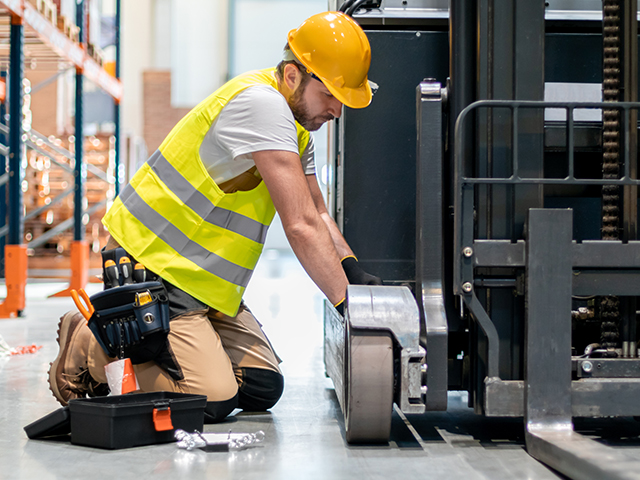
Even though tires are a high-wear item, you still want to do everything you can to get the most from your investment. One major way to do this is to ensure that you are using the correct tire on your lift truck. When it comes to selecting tires, considering how your truck will be used and the environment it will be operating in will go a long way to helping you determine what you need. Continue reading for some tips to help you select the right tires for the job.
Rubber or Polyurethane?
In general, rubber tires are used on internal combustion trucks while polyurethane (poly) tires are more common on electric lift trucks. Additionally, there are a variety of other factors to consider when choosing the right tire for your equipment, such as:
- Rolling Resistance – Poly tires offer less resistance than rubber. Because they are battery-powered, electrics trucks should use poly tires to conserve energy during operation and reduce downtime for recharging.
- Cushioning – The higher a tire’s durometer number, the harder the tire. A softer tire absorbs more impact and provides more cushioning. Because rubber tires have a lower durometer, they should be used if a softer ride is desired.
- Traction – Rubber tires offer a broader footprint over poly, thus giving them better traction. If you are still inclined to use a poly tire, modern versions now offer siping, or an engraved tread pattern, that lends them greater traction.
- Load Capacity – Because of their higher tensile strength, poly tires are more resistant to splitting, tearing, or chunking out under load than rubber tires are.
- Resistance to Cutting, Tearing, and Abrasions – As a general rule, poly tires will outlast a rubber tire by about four times. This is because poly tires are harder and less susceptible to cuts, tearing, and abrasions from sharp objects. Items that might cut a rubber tire will be deflected or become embedded in the much harder poly tire.
- High-Speed Operation – Polyurethane tires are more likely to fail due to heat buildup than rubber tires. This is because rubber tires can dissipate the heat better. For faster-moving trucks (propane and internal combustion) that see a higher buildup of heat, rubber tires are the way to go.
- Floor Marking – If marks on the floor (or a lack of) are a concern to you, then selecting a non-marking tire is an important consideration. While poly tires are naturally non-marking, black rubber tires will leave marks on the floor. You can get around this with special non-marking rubber tires.
- Response on Wet Floors – A smooth poly tire will have significantly less traction on wet floors than a rubber tire. If your operating environment requires a poly tire, consider one that has been siped to provide better traction.
- Chemical Resistance – Both poly and rubber tires are susceptible to chemicals in their environment. Knowing what type of chemicals your tires will come in contact with can help you choose between rubber and poly. It is best to use the right tire to match your needs to prevent costly failures.
- Price – While a rubber tire on average costs half of what a poly tire does, they typically don’t last as long. Based on typical use, a rubber tire may only last a quarter of the life of a poly tire. When choosing between poly and rubber, price shouldn’t be a deciding factor.
To sum up, rubber tires are often used indoors or outdoors where a softer ride or better traction is desired. Poly tires are used indoors on smooth concrete surfaces when a higher load capacity is required. However, how and where you will be using your forklift should also help you determine the correct compound for your tires.
Pneumatic or Cushion?
If you’ve decided that a rubber tire is the way to go, you still have another decision to make. Will you go with a pneumatic or cushion type?
Pneumatic – These tires are longer and wider than cushion style tires and are frequently used in outdoor applications. There are two options when choosing a pneumatic tire, solid or air-filled. Solid tires cost more because they are 100% rubber, but this makes them ideal for situations where punctures are an issue. Air-filled tires work great in environments with smooth operating surfaces.
Cushion – Cushion tires are solid rubber molded onto a steel band. Because they’re smaller than pneumatic tires, cushion tires have a smaller turning radius—making them a great choice for tight spaces. Cushion-style tires work well in smooth, indoor applications and cost less than pneumatic tires.
Hundreds of Options in One Place
Because forklifts are often designed for use with a certain type of tire, you should keep all of these variables discussed above in mind when purchasing a forklift. Selecting the wrong lift truck for the application you will be using it in will affect your efficiency, safety, and output. No matter what type of tire your lift truck uses, TVH has you covered. From press-on poly tires to solid pneumatic rubber tires, we have hundreds of options in stock and ready to ship. Regardless of whether you need smooth or traction, marking or non-marking, all of our tires are made from high-quality materials to provide you with the best possible product for your money. In addition to tires, TVH carries a multitude of accessories, including wheels and rims, tire presses, and even tire cover guards. Contact your sales representative today to place your order.
References
https://www.cervusequipment.com/forklifts/blog/forklift-tires-pneumatic-or-cushion/
https://www.forkliftaccessories.com/forkliftblog/polyurethane-tires-vs-rubber-tires/
https://www.thombert.com/userdocs/PolyurethaneRubberTires.pdf
https://www.forklifttire.com/tire-blog/five-major-benefits-of-polyurethane-tires/